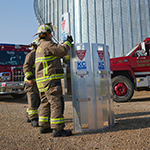Grain dryer safety
Follow these recommendations to help prevent dryer fires.
Extremely high yields, combined with below-normal temperatures and a wet harvest have many grain elevators, cooperatives and feed mills dealing with high-moisture corn and beans — and the hazards that come with extended grain drying. In October 2014, grain dryer fires more than double compared to the same period the year before.
Based on recent claims data, the primary causes of grain dryer fires include:
- Lack of operator training
- Lack of oversight or monitoring during dryer operation
- Lack of cleaning
- Running of dryers at high temperatures (greater than 200o F)
- Attempting to re-start a hot or warm dryer without a complete inspection
Losses in grain dryer fires aren’t limited to dryer equipment and grain. Grain dryer fires can result in considerable downtime, which can mean lost revenue and customers. The direct and indirect costs associated with dryer fires can be extensive, so precautions should be taken at every step.
The good news is, you can help reduce the risk of fire if you take a proactive approach to fire prevention. We’re asking grain dryer operators to immediately conduct employee training, including a thorough review of safety and operator’s manuals; to regularly shut down dryers for inspection, cleaning and maintenance; and to make sure that a qualified operator monitors the drying operation at least once every hour.
In addition, we encourage you to share the following recommendations outlined below with your employees to help prevent the occurrence of dryer fires:
Grain dryer operation
- Follow manufacturer’s operator’s manual.
- Regularly check grain condition, temperature and moisture levels to confirm proper dryer operation.
- Regularly inspect grain columns to help ensure columns are full and grain is flowing properly.
- Don’t let grain fines, bees’ wings, dust or debris accumulate inside the dryer.
- Keep areas around and under dryer clean and free of fines, bees’ wings, dust and debris.
- Inspect, look and listen on a regular basis.
Grain dryer shut down
- Follow manufacturer’s procedures for shutting down dryer.
- Lock out and tag out all electrical and mechanical systems before performing any maintenance.
Columns, grain exchangers and garners
- Clean internal and external dryer columns every 24 hours of continuous operation, or more frequently if recommended by manufacturer or if operating conditions warrant.
- Inspect and clean column screens and grain exchangers.
- Inspect and clean upper garners to help ensure grain columns fill correctly.
Burners and fans
- Inspect and clean burner and burner floor area.
- Inspect fans for accumulation of dust and debris that could affect proper operation.
- Inspect motors, bearings, belts and chains for excessive wear and tear, and make all necessary repairs.
- Make sure all equipment safety guards are in place and in good working order.
Gas and electrical
- Inspect entire gas train for physical damage or leaks.
- Confirm proper operation of gas valves.
- Inspect dryer unload system.
- Ensure electrical connection boxes are weather-tight and internal electrical connections are tight.
- Reset limit switches and test to determine operation prior to restarting dryer.
Fire detection
Even when taking precautions, grain dryer fires can still happen. In the event that a fire is detected, you should follow these safety recommendations:
- Stop dryer operation and grain flow into and out of dryer.
- Shut down gas, electrical and all other power sources.
- Call 911 or notify your local fire department.
- When possible, use a fire extinguisher and/or carefully remove burning debris/grain if the fire is small. (Watch the dryer closely for another fire after one has occurred.)
- Never convey grain through the dryer unloading system if overheated grain or fire is present.
- Inspect destination bin to insure fire hasn’t spread.
Restarting grain dryers
- Follow manufacturer’s operator’s manual for restarting a grain dryer.
- Don’t restart dryer until grain, trash and other debris have been removed and dryer is clean, and all gas, electrical and monitoring devices are operational.
- Never bypass dryer operational or safety controls in order to restart the drying process.

 >
>

 >
>
 >
>